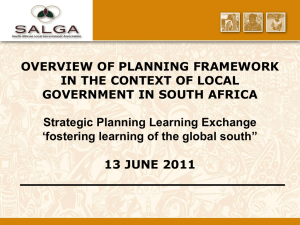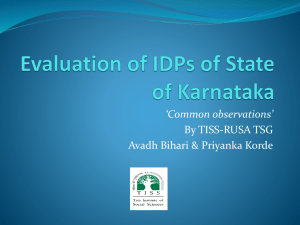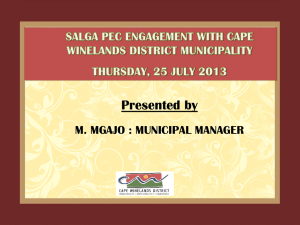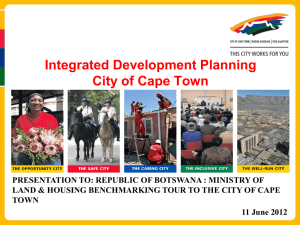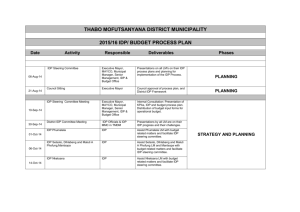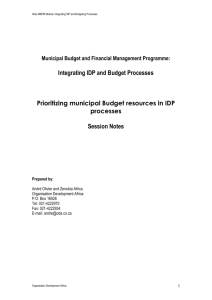presentation
advertisement
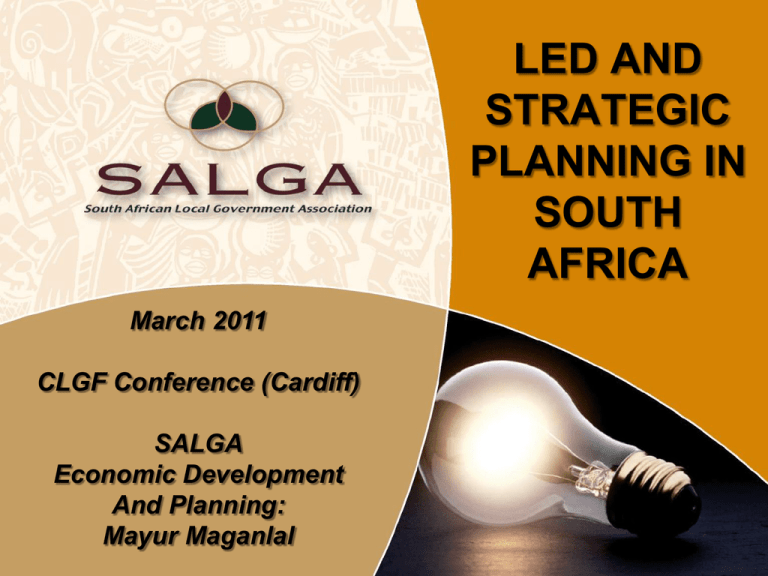
LED AND STRATEGIC PLANNING IN SOUTH AFRICA March 2011 CLGF Conference (Cardiff) SALGA Economic Development And Planning: Mayur Maganlal CONTENTS • Introduction: Development of LED Strategies in SA • Strategic Planning in SA: – Integrated Development Planning – LED Planning • Importance of LED Planning • Challenges of LED Planning • Salga focus on promoting effective LED planning INTRODUCTION: DEVELOPMENT OF LED STRATEGIES IN SA • A history of strong centralised planning and apartheid spatial development policies = little to no LED prior to the 1996 local government elections • Heralding in of a new local government structure (1996) – as an independent sphere of government in terms of the constitution • “Backlash” to apartheid planning has given strong impetus to local community-based planning (governance) • LED is now compulsory, through the Integrated Development Planning (IDP) process – Strong divergence between big urban (metro) and smaller urban/ rural Local Authorities, both with respect to the LED process, and actual LED results. – Also considerable questions around capacity to implement STRATEGIC PLANNING IN SA: INTEGRATED DEVELOPMENT PLANNING (IDP) • The IDP is an strategic development plan for a the 5 year Mayoral Term and is reviewed annually with budget cycle. (Municipal Systems Act, 32 of 2000) • Components of the IDP include: – Long term strategic plan (also intergovernmental alignment) – Stakeholder needs and political priorities (consultation) – Sector plans (environment, LED, transport, Water Services Development Plans) – Intergovernmental alignment, – Financial Plan (budget alignment and SDBIP) – Institutional plan (HRD and governance) – Performance indicators (basis of organisation and individual PMS) • Provincial government provides oversight and responsible for vertical and horizontal alignment • Regular reporting with budget and PMS (oversight by AG and annual report) 4 STRATEGIC PLANNING IN SA: EVOLUTION OF IDP’S 2nd Generation 3rd Generation 1st Generation Aim: • Introduce IDP in mun areas • Inform equitable services in new municipal entities (backlogs) • Community participation methodology GAP? • Budget format • Performance management systems • Sector planning link to IDP Aim: • “Credible” IDPs across province Shift: • IDP as ‘whole of govt plan’ • Stronger ‘long term strategy’ in IDP • Strengthen ward-level engagement • Sector Department engagement (incl. LGMTEC) • Improve IDP-Budget link GAP? • Provincial investment plan • Weak local spatial plan • Citizens not well-connected to IDP (local responsibility and impact) 2009 11 2001 - 2005 STABILISATION Dec 2000 – 2002 2006 –2010 MUNICIPAL CONSOLIDATION Jan 2003 – Dec 2010 Aim: • Clear geographic investment plan • IDP embedded in neighbourhoods Shift: • IDP ownership by leadership • Spatial logic guides 5yr investment per mun area by whole of govt • Ward-neighbourhood plan with clear service action (marginalised) • Harness resources of partners - business, civil society, labour Prepare: - Good information per mun area - Execute participation method - Spatial planning logic - Ward/neighbourhood plan 2011 - 2015 SUSTAINABILITY Dec 2010 - Beyond STRATEGIC PLANNING IN SA: LED PLANNING • Constitution gives local government the responsibility to promote social and economic development • The 2006 LED National Framework & associated toolkit, issued by dplg bridges many debates and provides clarification on roles & responsibilities • No clear indication of implementation of this National Framework • IDP’s and LED Plans have to be aligned to – National and Provincial Strategies (GDS, PGDS, NSDP and more recently the New Growth Path) – National, Provincial and Agency plans and policies and vice-versa IMPORTANCE OF LED PLANNING • Local economic development (LED) creates opportunities for local government, the private and not-for-profit sectors and local communities to work collectively in creating better conditions for competitiveness and inclusive, sustainable economic growth. • It is also seen as one of the most important ways of decreasing poverty and bringing together key municipal stakeholders to promote economic growth and development. • Strategic planning around LED focuses on key principles like: – Creating local partnerships – Using local resources – Adopting a flexible approach to respond to changing circumstances IMPORTANCE OF LED PLANNING • A credible LED Strategy should include the following: – Alignment of critical pieces of strategies and policies - As outlined above and new growth path etc) – Consideration of spatial issues (alignment to SDF) – The empirical and statistical evidence to support development thrusts: socio – economic, census and other data (and means to unpack it) – Consideration for the financial implications – Must have evidence of stakeholder and community involvement – Objectives should be obtainable and measureable – Timeframe for critical milestones during implementation – Make considerations management arrangements and SMME support (establishment of agencies and entities) IMPORTANCE OF LED PLANNING • LED policies and plans will be council’s declaration of what they intend to do to support LED in respect of: – – – – – – – Procurement Support and development of key business sectors and types SMME support Creation of a conducive LED climate LED incentives Focus on formal and informal sectors Other key priority areas • Alignment of plans – The alignment of LED with IDP – The monitoring and appraisal of LED projects and programmes through the PMS – The importance of LED in the context of IGR (district, provincial and national) – The existence of LED strategies and related implementation plans CHALLENGES TO LED PLANNING Planning and alignment: • Process for intergovernmental alignment of LED (strategy and programmes) happens mainly at legislation level: – Poor integration with national programmes such as EPWP, industrial incentives, tourisms, etc – Integration of municipal and Provincial plans • Need for a close relationships between established business and municipalities (increasing antagonism) • Very little reporting and M&E in place to provide any kind of feedback and support • Access to data for LED limited Content of plans • Missing LED success factors such as: − Market access strategies and demand versus supply side strategies − Integration into existing value chains versus new initiatives − An inability to correctly identify capacity constraints CHALLENGES TO LED PLANNING Oversight and capacity • LED Leadership is often not being given the political weight and attention it deserves as one of the key priorities of local government • Big cities have dedicated Economic Development departments or Units, while most smaller LAs don’t even have a dedicated counselor • There are some Local Municipalities that have very limited capacity to develop effective LED strategies and implement them CHALLENGES TO LED PLANNING Quality of plans • In poorer areas plans are still project-driven, have unrealistic targets, strong belief that having a plan = success and limited M&E in place to provide feedback • Question: support and building capacity vs rethink some areas of decentralisation • In urban municipalities need special attention and must be supported to understand their unique LED role in contributing to the national economy. • Specific interventions for urban centres will include: – Focusing on making urban land markets work for the poor; – Promoting more competitive city business environments and facilitating the movement of information, people and products within and between cities – Promoting appropriate economic integration zones – Market Access strategies and demand versus supply side strategies (planning unit issue?) – Integration into existing value chains versus new initiatives UNDERSTANDING ROLES AND RESPONSIBILITIES Macroeconomic and Micro economic Trade Promotion (international, continental and local) Incentives Tourism Mining, Agriculture, Forestry, Fisharies Sector Education and Training Authorities Transportation Pubic Enterprises (SITA, Tourism, Small Business Support and Financing) National Planning Commission Police Marketing Broadbased Black Economic Empowerment Labour National Regulation (competition commission) Provincial Agencies Interventions Tourism Marketing Infrastructure Provincial Traffic Safety (Traffic) Informal Trading Local Regulation (planning, building, environ’tal health, other bylaws) ICT Projects SMME Support Infrastructure NEW GROWTH PATH DRIVERS 1. Address cost drivers and inflationary pressures across the economy 2. Active industrial policy based on increasing competitiveness and targeting sectors that can create employment directly and indirectly 3. Comprehensive rural development 4. Stronger competition policy 5. Stepping up education and skills development 6. Enterprise development 7. Reform of Broad-Based BEE 8. Reform labour policies to support productivity and improve protection for vulnerable workers 9. Technology policies geared to improving innovation in ways that support employment creation and small- and micro-enterprise 10. Developmental trade policies with a strong orientation to new growth centres 11. Investment to support African development SoNA: – R9 billion in the Jobs Fund over the next 3 years – public employment schemes plus subsidies to private employers – R10 bn from the IDC in next 5 years for jobcreating projects – R20 billion in investment subsidies – Comprehensive support for SMEs 14 SALGA FOCUS ON PROMOTING BETTER LED PLANNING • Encouraging a greater focus on LED (pro-growth strategies) as a separate priority within IDP • Working to establish better relationships with established business, and better integrate them into the planning process (business environment surveys, forums, etc) • Gathering and disseminating LED practices and experiences and developing sustainable knowledge platforms • Support and encourage better planning and alignment between District and Local Municipality strategies and across spheres SALGA FOCUS ON PROMOTING BETTER LED PLANNING • Increasing alignment of national government initiatives and the ability to access government funding by: − Municipalities increased participation in EPWP (promoting labour intensive job creation) − Municipal Tourism Development − Access to DTI Incentives and other areas of National Stimulus Package • Improving technical and analytical skills at a local level

